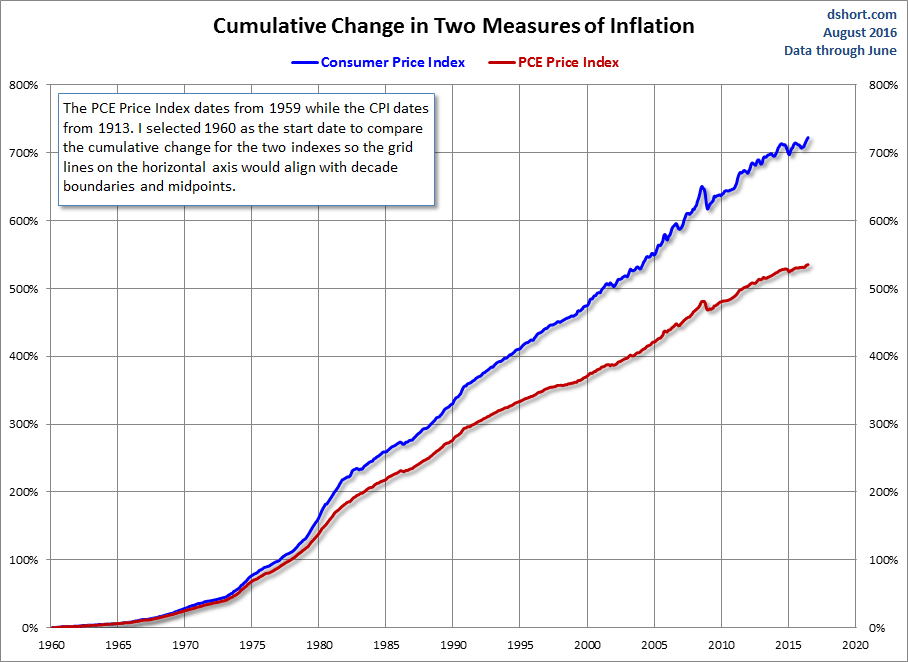Two Measures Of Inflation: CPI And The PCE Price Index And Fed Policy
The BLS's Consumer Price Index for March shows core inflation below the Federal Reserve's 2% long-term target range at 1.66%. The Core PCE price index at the end of the February (the most recent data), is significantly lower at 1.10%. The Fed is on record as preferring Core PCE as its inflation gauge.
| The inflation rate over the longer run is primarily determined by monetary policy, and hence the Committee has the ability to specify a longer-run goal for inflation. The Committee judges that inflation at the rate of 2 percent, as measured by the annual change in the price index for personal consumption expenditures, is most consistent over the longer run with the Federal Reserve's statutory mandate. Communicating this inflation goal clearly to the public helps keep longer-term inflation expectations firmly anchored, thereby fostering price stability and moderate long-term interest rates and enhancing the Committee's ability to promote maximum employment in the face of significant economic disturbances. [Source] Note: Bolding added by me. |
Elsewhere the Fed stresses the importance of longer-term inflation patterns, the likelihood of persistence and the importance of "core" inflation (less food and energy). Why the emphasis on core? Here is an excerpt from one of the Fed FAQs.
| Finally, policymakers examine a variety of "core" inflation measures to help identify inflation trends. The most common type of core inflation measures excludes items that tend to go up and down in price dramatically or often, like food and energy items. For those items, a large price change in one period does not necessarily tend to be followed by another large change in the same direction in the following period. Although food and energy make up an important part of the budget for most households--and policymakers ultimately seek to stabilize overall consumer prices--core inflation measures that leave out items with volatile prices can be useful in assessing inflation trends. [Source] |
Fed's Short-Term Target Broadened to 2% to 2.5%
In the shorter term, however, the Fed has raised the top range of its inflation target by half a percent. The change was announced to the public in the December 12, 2012 FOMC press release:
| ...the Committee decided to keep the target range for the federal funds rate at 0 to 1/4 percent and currently anticipates that this exceptionally low range for the federal funds rate will be appropriate at least as long as the unemployment rate remains above 6-1/2 percent, inflation between one and two years ahead is projected to be no more than a half percentage point above the Committee's 2 percent longer-run goal, and longer-term inflation expectations continue to be well anchored. [Source] |
The October 2010 core CPI of 0.61% was the lowest ever recorded, and two months later the core PCE of 0.95% was an all-time low.

This close-up comparison gives us clues as to why the Federal Reserve prefers Core PCE over Core CPI as an indicator of its success in managing inflation: Core PCE is considerably less volatile than CPI. Given the Fed's twin mandates of price stability and maximizing employment, it's not surprising that in the past the less volatile Core PCE has been their metric of choice. On the other hand, the disinflationary trend in Core PCE continues to cast doubt on the effectiveness of the Fed's monetary policy.
The Bureau of Labor Statistic's Consumer Price Index and The Bureau of Economic Analysis's monthly Personal Income and Outlays report are the main indicators for price trends in the U.S. The chart below is an overlay of core CPI and core PCE since 2000.
Here is a long-term perspective from the actual beginnings of the two series.
Here is a chart that helps us compare the cumulative change in the two indexes since 1960. Over time, the PCE price index reflects significantly lower growth in inflation than does CPI.
For some technical data explaining the differences between the calculation of PCE and CPI, see this comparison article from the BEA.
In the real world we can't exclude food and energy from our monthly expenses. But the extreme volatility of these two expense categories, especially energy, often obscures the underlying trend, which is the focus of the chart above. For evidence of the volatility, see this overlay of headline and core CPI and this one of headline and core PCE.
Hostility Toward Government Inflation Analysis
One the other hand, the volatile price of gasoline explains why so many people are angered by the exclusion of food and energy from core measures of inflation. The chart of gasoline prices below is based on the latest weekly data from the Energy Information Administration. The price volatility of gasoline in recent years has been quite dramatic.
I'll update these charts shortly after the next PCE report is released.







